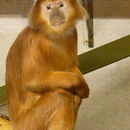Biology
(
Inglês
)
fornecido por Arkive
The Javan langur is a diurnal and arboreal primate (5). It feeds mainly on leaves, fruit, flowers, flower buds, and insect larvae and, like other members of the Colobinae subfamily, has evolved a specialised stomach to digest plant material more efficiently (3). This species also has enlarged salivary glands to assist it in breaking down food (5).
This langur lives in social groups of around seven individuals, with one or two adult males in the group (5). Adult females are aggressive towards females from other groups, and have been observed looking after the offspring of other mothers, as well as their own. It is thought that juveniles are brightly coloured because this alerts females to their presence and ensures that they will always be noticed and protected (3) (5). Mating occurs throughout the year and females produce one offspring at a time (5).
Conservation
(
Inglês
)
fornecido por Arkive
The species is currently found in 3 protected areas – Gunung Halimun NP, Pangandaran NR and Ujung Kulon NP (2). In addition to protecting the remaining forest habitat, it is essential that more is done to stop hunting and the bush meat trade in this part of the world (7). Without human intervention and protection, the endangered Javan langur will face extinction in the future (3).
Description
(
Inglês
)
fornecido por Arkive
The name 'langur' means 'long tail' in Hindi (4), and this species' tail is indeed noticeably long, measuring up to 87 cm in length while the body is only around 55 cm long (2) (3). There are two subspecies of the Javan langur: the eastern Javan or spangled ebony langur (Trachypithecus auratus auratus) has two distinct colourations: the more common one being glossy black in colour with a slight brownish tinge on the sides of the body, 'sideburns', and legs (5). The skin of the face, palms and soles is also black. The rarer form of this subspecies is a deep orange colour with yellow tinges on the side of the body, limbs and hair around the ears, and black tinges on the back (5). The second subspecies, the western Javan or West Javan ebony langur (Trachypithecus auratus mauritius) is glossy black with a very slight brownish tinge on the sides of the body, sideburns and legs (5). Female Javan langurs can be distinguished from males by the pale, yellowish white patch around the pubic area. Juveniles are even more distinctive as they are orange in colour (6).
Habitat
(
Inglês
)
fornecido por Arkive
Inhabits the interior and peripheral areas of rainforests (5).
Range
(
Inglês
)
fornecido por Arkive
This species is found on the island of Java and the smaller islands of Bali and Lombok, Indonesia, though the subspecies are geographically separated (5). The subspecies Trachypithecus auratus auratus is found between Blitar, Ijen, Pugeran, eastern Java and Gunung Ujungtebu, while the subspecies Trachypithecus auratus mauritius has a restricted distribution from west Java to Jakarta, as well as inland in Bogor, Cisalak, Jasinga and Ujung Kulon, then along the south coast to Cikaso or Ciwangi (5).
Status
(
Inglês
)
fornecido por Arkive
Classified as Endangered (EN B1+2ab) on the IUCN Red List 2004 (1). Two subspecies are recognised: Trachypithecus auratus auratus is classified as Endangered (EN A1c, B1+2cd), and Trachypithecus auratus mauritius as Endangered (EN B1+2ab) on the IUCN Red List 2004 (1).
Threats
(
Inglês
)
fornecido por Arkive
This primate is threatened by the destruction of its habitat for timber and cultivation (1). In Indonesia there have been cases of local people deliberately setting fire to forest to clear it for agriculture, which has had devastating consequences for this arboreal monkey (3). Hunting is also a major threat in Indonesia, and the increased availability of firearms has made the problem worse (3).

